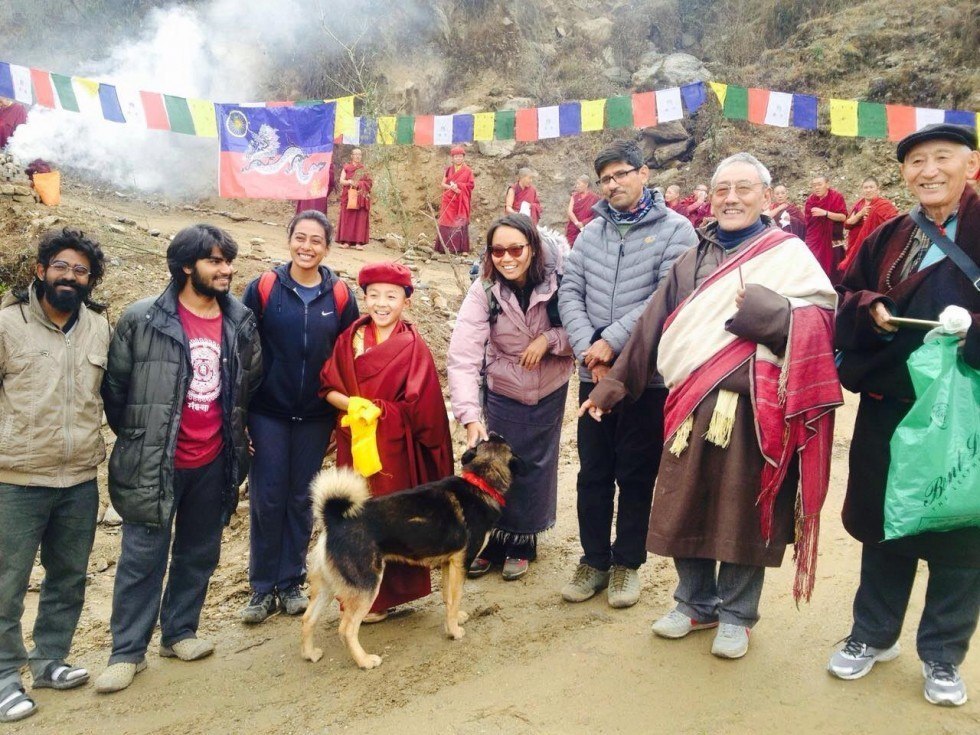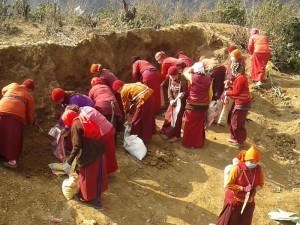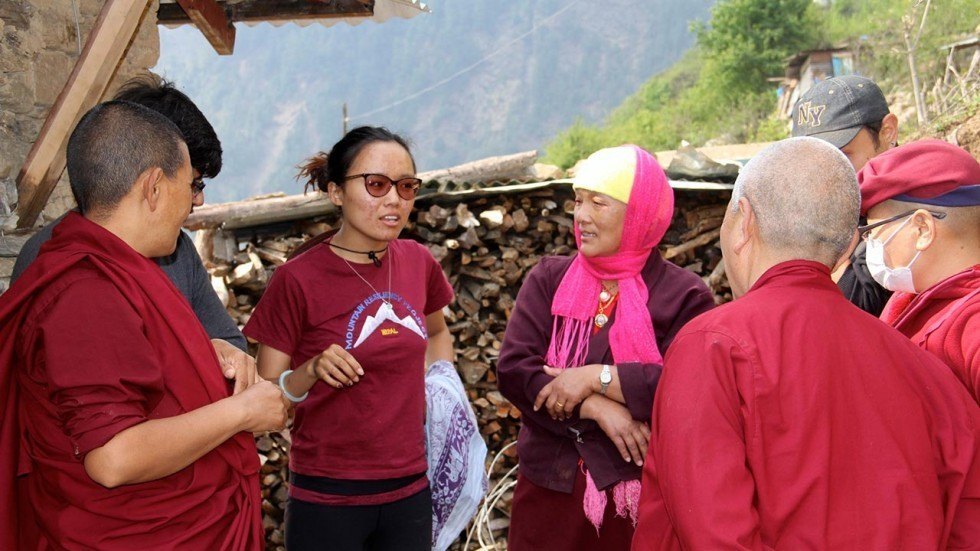This is the second post marking the first anniversary of Nepal’s 7.8 magnitude earthquake—the worst to hit the small South Asian nation since 1934. It highlights the heroic story of Tsechu Dolma, a Tibetan woman who worked with our grantees to deliver desperately-needed aid to a hard-hit, hard-to-reach mountain community.
Just days after the first of two massive earthquakes struck Nepal on April 25, 2015, Tsechu Dolma ascended one of the most remote mountaintops in the country on a mission to rescue survivors. Her herculean journey—made possible by plane, helicopter and forceful advocacy—demonstrated resourcefulness and courage far beyond someone in her early 20s.

Tsechu, a Tibetan refugee who spent part of her childhood in Nepal and part in New York, is a consultant to AJWS grantee Sengedag Service Society (SSS), which serves Tibetan refugee Buddhist nuns and monks in remote mountain communities in Nepal’s Sindhupalchowk District. SSS leaped into action when it learned the earthquake destroyed all 207 homes in the Bakhang Nunnery and injured 210 nuns and monks, leaving them homeless and devastated and forcing them into a crowded displacement camp in Kathmandu.
AJWS’s grant is helping SSS build 60 earthquake-resilient homes and construct a 27-kilometer road so essential supplies can be delivered to an area previously only accessible by foot on a steep incline. We’re also supporting the Hunnarshala Foundation, which is providing SSS with technical assistance from engineers and architects to guide construction projects and train community members.

Tsechu knew that the Tibetans were unlikely to receive aid from the Nepal government because they lack legal documentation and have been largely ignored by Nepalese society. As refugees, they were also cut off from their families: “The nuns who came to Nepal were sent by their parents when they were really young because there weren’t any prospects for them in Tibet. They don’t have any familial support system in Nepal. They’re all by themselves.”
Undeterred by the terrain or the politics, Tsechu made it her mission in the early days after the disaster to ascend the mountain to assess what could be done. She met resistance at the airport because of her age and gender, but she didn’t let it stop her.
“At that time, the Nepali government wasn’t letting any private helicopters off the ground,” she said. “I had to wait in the airport for 12 hours and do a lot of negotiating and finding allies to back me up. It was a lot of screaming to get my voice heard, but I finally got people to understand the importance of getting the help there.”

After a couple days of lobbying, Tsechu, SSS and other groups found a willing pilot and convinced high lamas—powerful spiritual leaders in the Tibetan community—and Tibetan community leaders to travel with her.
They landed to find a harrowing scene of razed buildings and loose rocks threatening more damage by the minute because of active landslides—a reality in a landscape marked by glaciated mountains reaching over 5,000 meters in elevation. All the monastery and nunnery houses—which were hand-built by the nuns—were destroyed. One nun and 64 residents of the nearby villages died, and 30 nuns were nursing serious injuries caused by the earthquake and their living conditions in its aftermath.
“Everything was unlivable,” Tsechu said. “200 nuns were sleeping under one blue, 720-square-foot tarp in a tight space. Many fell when running after their homes collapsed or were hit by falling rocks. Many had muscle pains, infections, diarrhea or constipation. We arranged for a doctor to come, and all the nuns and villagers lined up. Some villagers even walked four hours to reach the doctor.
“A lot of the nuns were still crying,” she continued. “They were still mourning for the one who passed away, and shaken to the core by everything that had happened.”

Fluent in both Tibetan and Nepali, Tsechu translated for the doctor and counseled the survivors. She says the government helped the nearby villagers—all Nepali citizens—and ignored the nuns. After persistent advocacy work, she and her partners secured eight helicopter shuttles to rescue 20 severely injured nuns and villagers, deliver temporary shelter materials and transport experts and Tibetan leaders to support the nuns.
About 30 of the nuns were on meditation retreat in isolated huts when the earthquake struck—and, despite the trauma, they didn’t want to leave. It took a lot of pleading by Nepali doctors who had been running health camps in the area to pull them out of the retreat.
“According to Buddhist prayer books, you can’t leave [in the middle of a spiritual] practice—even if there’s a fire or a flood happening,” Tsechu explained. This caused a spiritual crisis for many of the nuns who felt they had violated their faith by interrupting the retreat after the earthquake. “We had high lamas come and talk to the nuns and tell them, ‘it’s not your fault that you left. These things happen.’”
SSS helped relocate 150 nuns and monks to a temporary resettlement camp outside Kathmandu.
Tsechu hopes that the earthquake relief efforts can be a springboard for many aid agencies to delve more deeply into the other critical issues facing the Tibetan refugee community in Nepal, like domestic and sexual violence, health care, economic development and education deficits.
“I hope it can serve as an example and platform for other Tibetan youth and women to speak up, take leadership and be seen,” she added. “Currently, all leadership positions in our community are predominantly being done by older men and this dynamic is leaving out the voices of the most vulnerable in our community.”

Before Tsechu and her partners arrived, she says, “there was nothing being done for the wellbeing of Tibetan refugees in Nepal” in the first month after the earthquake. Now, thanks to advocates like Tsechu, the community is making inroads in its recovery process. “I didn’t have enough funding or capacity to do everything myself,” she said, “but creating partnerships with larger NGOs allowed me to draw attention and funds for Tibetan refugees.”
Responding to the earthquake not only brought Tsechu back to Nepal; it reconnected her with a community with whom she shares deep roots. She is glad the Tibetan nunnery was the first recovery project she took on: “We were familiar with this community,” she said. “It makes so much more sense for me to work with Tibetan refugees than to go to work with [other groups needing support after the earthquake, such as] Nepalese migrant workers. I know their background, and I’m part of the community.”
AJWS’s work in countries and communities changes over time, responding to the evolving needs of partner organizations and the people they serve. To learn where AJWS is supporting activists and social justice movements today, please see Where We Work.

